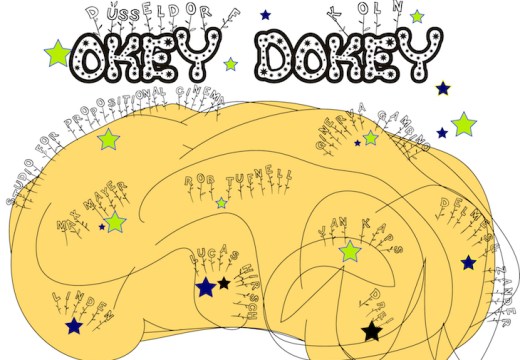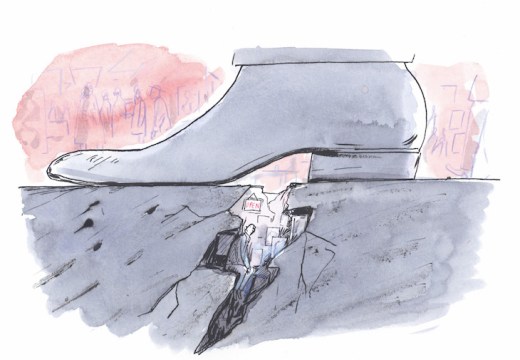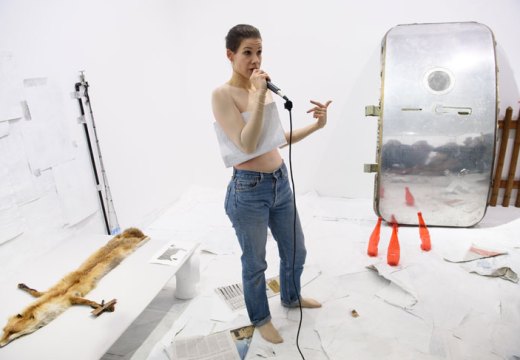Now in its third edition, Condo is a collaborative exhibition by 46 international galleries across 17 London spaces. The number of participants has grown steadily with each iteration, and the premise remains the same: host galleries open up their space to visiting galleries – either by realising an exhibition together, or by dividing up their exhibition space for discrete projects. Originally conceived by Vanessa Carlos of London’s Carlos/Ishikawa as a way for galleries to work collegiately – pooling resources and reducing overheads in the exorbitant age of the art fair – the model has grown, spreading last year to New York and with plans afoot for expansion to São Paulo, Shanghai and Mexico City.
The collaborative model leads to a thoughtfully composed group exhibition at the new London outpost of mother’s tankstation (originally from Dublin) on Holborn Viaduct, which hosts Edouard Malingue of Hong Kong and Shanghai. The two galleries each bring three artists from their roster to an exhibition which meditates on understated gestures of the everyday. He Yida’s abstract compositions comprised of humble materials – in this case PVC and gaffer tape – suggest a dialogue with arte povera, finding beauty in the humble or overlooked. Australian artist Noel McKenna’s paintings on plywood and ceramic tiles figure the quotidian through depictions of interior spaces and objects belonging to the artist.

Die Unsrigen sind fortgezogen (2014), Michaela Eichwald. © Michaela Eichwald, courtesy dépendance, Brussels and Maureen Paley, London
Other host galleries take a more hands-off approach, such as Maureen Paley in Bethnal Green, which has given over nearly the entirety of its gallery space to two guests. Brussels gallery dépendance exhibits work by German artist Michaela Eichwald in the upstairs gallery: a series of paintings on pleather rendered in dark greens and dirty browns, a gruff take on gestural abstraction that, like the works at mother’s tankstation, rejects preciousness. Downstairs, Mexico City’s joségarcía, mx presents work by the Los Angeles-born, Guadalajara-based artist Eduardo Sarabia. And at the very back of the room is a modest viewing space for work by Maureen Paley artists; the two visiting galleries have here received a generous welcome. All three businesses are roughly comparable in terms of stature, artist rosters and resourcing. Looking ahead, might the host reasonably expect similar hospitality in return? How does this undoubted goodwill play into future relationships?

Installation view, ‘Eduardo Sarabia’, Maureen Paley, London, 2018. © Eduardo Sarabia, courtesy joségarcía, Mexico City and Maureen Paley, London
Over in Soho, Sadie Coles HQ hosts two younger galleries: Lisbon’s Madragoa and Koppe Astner of Glasgow. The visitors are afforded a much smaller proportion of exhibition space here, yet Estonian artist Kris Lemsalu’s sculptural figurations stand out in Koppe Astner’s two-person presentation of her work alongside Josh Faught. A standing figure, with knitted lips for a head and twelve feet protruding from its robes, cradles a smaller creature in its arms. The work is titled Mysteriously conceived and deeply felt (2018); an uncanny conflation of human and animal, it warps Madonna and Child iconography to delightfully grotesque extremes.

Installation view, CONDO 2018, Koppe Astner at Sadie Coles HQ, London, 2018. Photo: Robert Glowacki; © the artist, courtesy Sadie Coles HQ, London and Koppe Astner, Glasgow.
This kind of collaboration between established and younger galleries suggests Condo has a reach beyond the grassroots, and that there is appetite for self-organisation across all tiers. For a visiting gallery, the ability to present a programme in London without the associated costs of an art fair booth represents a welcome financial reprieve, particularly given the recent spate of mid-tier gallery closures. Further, fewer economic risks would hopefully engender greater creative ones.
Yet questions remain: how are galleries selected? How many other galleries could have participated, if they wanted to? Do host galleries decide who they host? There is much to admire in Condo’s proposition: the imperative to work together more; to return the commercial presentation of art to the gallery space and exhibition format; to raise questions of the still proliferating, and financially punishing, art fair system. Yet with the rapid expansion of Condo to multiple new cities on the horizon, could this new model unwittingly replicate that very same art fair treadmill, tempting dealers to overreach and fall prey to the overheads? Even without the cost of an art fair booth, committing staff resources, shipping costs and sheer energy in the name of building audiences in new cities could undermine the long-term stability of some of those newer spaces that Condo admirably seeks to support.
Condo 2018 is at various venues in London until 10 February.
Unlimited access from just $16 every 3 months
Subscribe to get unlimited and exclusive access to the top art stories, interviews and exhibition reviews.














![Masterpiece [Re]discovery 2022. Photo: Ben Fisher Photography, courtesy of Masterpiece London](http://www.apollo-magazine.com/wp-content/uploads/2022/07/MPL2022_4263.jpg)
It’s time for the government of London to return to its rightful home